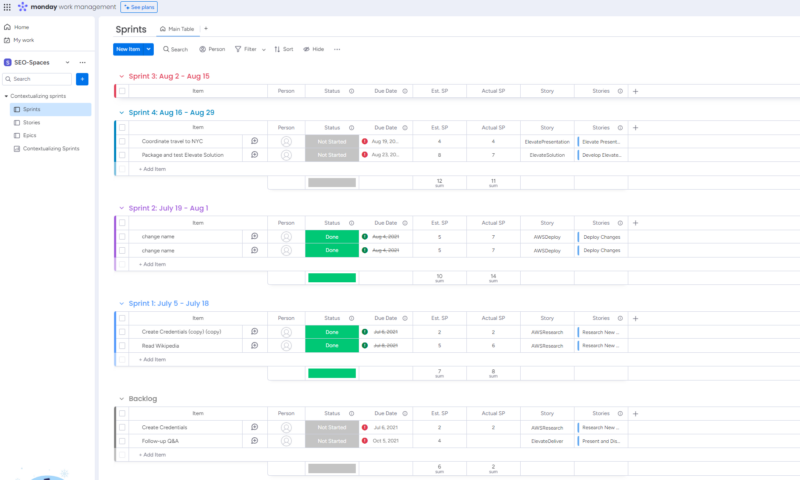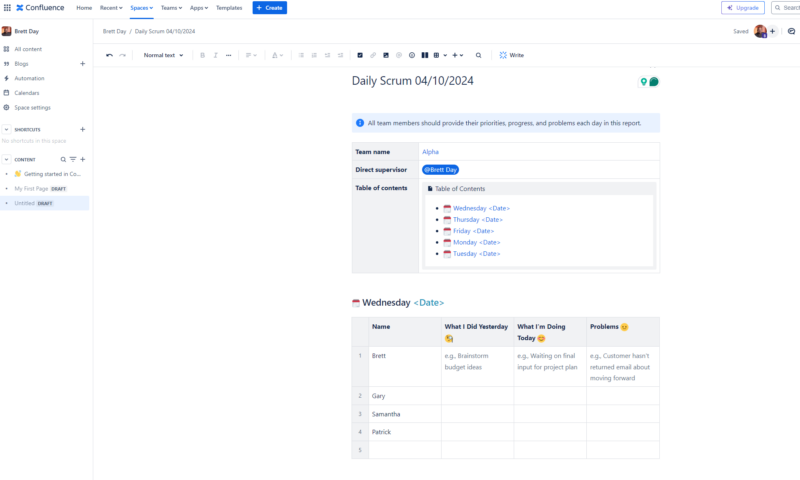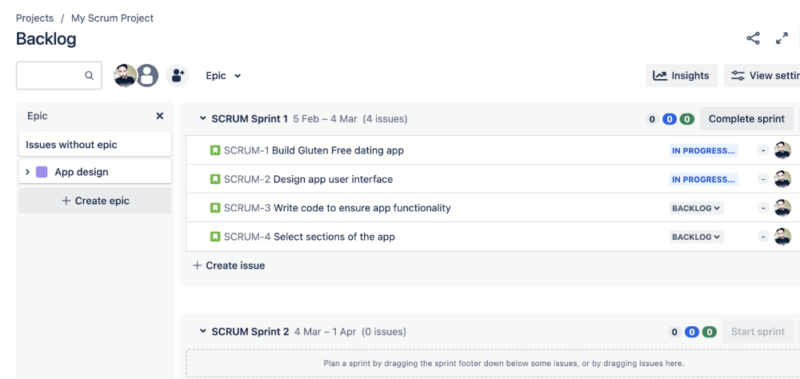The multitude of scrum events can strike fear into the hearts of those who are new to the Agile framework. However, though they seem complicated, these scrum meetings are nothing to be afraid of. In fact, when embraced and used in conjunction with the best project management software, they can greatly increase the chances of success for the project you’re working on.
In this guide, we’ll explain what scrum events are, what they’re used for, who should attend and how long they last. We’ll provide samples of scrum event calendars and scrum event cheat sheets, and explain what scrum artifacts and backlog refinement are. We know you’re eager to learn, so let’s jump in.
Definition: What Are Scrum Events?
Scrum events, also known as inspect and adapt events, are meetings that take place during a project. The events allow scrum teams to discuss work, demo software, plan, meet clients’ stakeholders and discuss wins and losses.
Scrum Ceremonies or Scrum Events?
Scrum events are sometimes called scrum ceremonies or scrum inspect and adapt events. Don’t let the different terminology fool you; all of these terms refer to the same concept. The official term in Scrum is scrum events; however, many other Agile methodologies that use the same meetings refer to them as ceremonies.
How Many Scrum Inspect and Adapt Events Are There?
In total, there are five official scrum inspect and adapt events, all of which take place frequently. If your organization uses the Scrum framework, you’ll find yourself taking part in the following events:
- The sprint
- Sprint planning
- Daily scrum
- Sprint review
- Sprint retrospective
The 5 Scrum Events in Order
In the following section, we’ll closely examine the five scrum events and provide more detail about each meeting. You’ll learn what happens during the event, who attends and more.
1. The Sprint
Unlike the other scrum events, a sprint is not a meeting. It’s a timeboxed period of work that lasts one to four weeks. A sprint is called a container event because it houses all the other scrum events. When one sprint is complete, another begins. This cycle repeats itself until the project is complete.

2. Sprint Planning Meeting
The sprint planning event ensures the product owner and the development team understand what needs to be accomplished during the sprint.
3. Daily Scrum
The scrum master leads daily scrum meetings with scrum developers to increase the likelihood of delivering a working product increment by the end of the sprint.

record responses to daily scrum questions.
4. Sprint Review Meeting
The purpose of the sprint review is for the team to meet with clients and stakeholders, demo the latest version of the software and collaborate on the sprint backlog.

5. Sprint Retrospective
The final scrum event, the sprint retrospective, takes place so the team can review the previous sprint, discuss Scrum and Agile best practices, celebrate wins and boost team morale.
Which Scrum Events Are Timeboxed, and Who Attends?
All scrum events are timeboxed, and different people attend each event. The table below breaks down each scrum event and lists what the events cover, how long they last and who attends.
| Event: | Reason | Length | Attendees |
|---|---|---|---|
| The Sprint | A timeboxed period to complete work requested by clients & stakeholders | One to four weeks | Scrum master, PO*, development team |
| Sprint Planning | To plan work for the upcoming sprint | Eight hours for a one-month sprint | Scrum master, PO, development team |
| Daily Scrum | For developers to discuss what they have worked on & what they will work on next, & to identify impediments | Fifteen minutes | Scrum master, development team |
| Sprint Review | To demo the latest product iteration & receive feedback from clients & stakeholders | Four hours for a one-month sprint | Scrum master, PO, development team, clients, stakeholders |
| Sprint Retrospective | To discuss the previous sprint, discuss what can be done better during the next sprint & increase the scrum team’s effectiveness | Three hours for a one-month sprint | Scrum master, PO, development team |
Is Product Backlog Refinement a Scrum Event?
Product backlog refinement is not an official scrum event. Backlog refinement occurs during sprint reviews. The idea behind backlog refinement is to reorganize and prioritize stories (tasks) that the scrum development team has to work on in the next sprint.
What Are Scrum Artifacts?
Scrum artifacts are the plans that scrum teams use to complete iterations of the product. They are transparent and readily available for the team, clients and stakeholders to view at any time. Examples of artifacts include the product backlog, the sprint backlog, and current and previous increments of the product being worked on.
Scrum Events Calendar
All scrum masters should create a scrum events calendar that shows when each scrum event will occur. The calendar should list not only the date the event will be held but also the time and location of the meeting. The image below shows a sample scrum events calendar that covers a two-week sprint.
Scrum events calendars can be created in many project management software platforms. Software like monday.com and ClickUp offer calendar templates that can help you create calendars quickly, or you can create your own from scratch. You can learn more about monday.com in our monday.com review and ClickUp in our ClickUp review.
Scrum Events Cheat Sheet
If you have recently started using Scrum in your place of business, creating a scrum events cheat sheet can be beneficial. The cheat sheet, which should be placed in a central location, can help inform the entire scrum team of each event and provide tips on how they can prepare for each meeting. Below is a sample of a scrum events cheat sheet.
Final Thoughts
Scrum is a relatively simple Agile framework, but it does have its fair share of events, which can confuse new teams. As long as you follow this guide and stick to the events in the order we listed, your team should have no problem adjusting to the scrum ceremonies. When conducted properly, scrum events can help scrum team members successfully complete projects.
What are your thoughts about the events in the Scrum framework? Do you find that they help or hinder teams? Do you know of any scrum event best practices you’d like to share? Let us know in the comments. Thanks for reading.
FAQ: Scrum Events in Agile
-
The five scrum events are the sprint, sprint planning, daily scrum meetings, sprint reviews and sprint retrospectives.
-
The four events in Scrum would be sprint planning, daily scrum meetings, sprint reviews and sprint retrospectives. In some circles, the sprint is not considered an event, which is why there is one less than the official number of events.
-
The five official phases of Scrum are initiation, planning and estimation, implementation, reviewing and releasing.
-
Scrum only has five ceremonies: the sprint, sprint planning, daily scrum meetings, sprint reviews and sprint retrospectives. Some would consider backlog refinement the sixth ceremony; however, it is not an official scrum event.
{“@context”:”https:\/\/schema.org”,”@type”:”FAQPage”,”mainEntity”:[{“@type”:”Question”,”name”:”What Are 5 Scrum Events?”,”acceptedAnswer”:{“@type”:”Answer”,”text”:”
The five scrum events are the sprint, sprint planning, daily scrum meetings, sprint reviews and sprint retrospectives.\n”}},{“@type”:”Question”,”name”:”What Are the 4 Events in Scrum?”,”acceptedAnswer”:{“@type”:”Answer”,”text”:”
The four events in Scrum would be sprint planning, daily scrum meetings, sprint reviews and sprint retrospectives. In some circles, the sprint is not considered an event, which is why there is one less than the official number of events.\n”}},{“@type”:”Question”,”name”:”What Are the 5 Phases of Scrum?”,”acceptedAnswer”:{“@type”:”Answer”,”text”:”
The five official phases of Scrum are initiation, planning and estimation, implementation, reviewing and releasing.\n”}},{“@type”:”Question”,”name”:”What Are the Six Scrum Ceremonies?”,”acceptedAnswer”:{“@type”:”Answer”,”text”:”
Scrum only has five ceremonies: the sprint, sprint planning, daily scrum meetings, sprint reviews and sprint retrospectives. Some would consider backlog refinement the sixth ceremony; however, it is not an official scrum event.\n”}}]}
The post Scrum Events: Artifacts, Diagram & Cheat Sheet in 2024 appeared first on Cloudwards.

